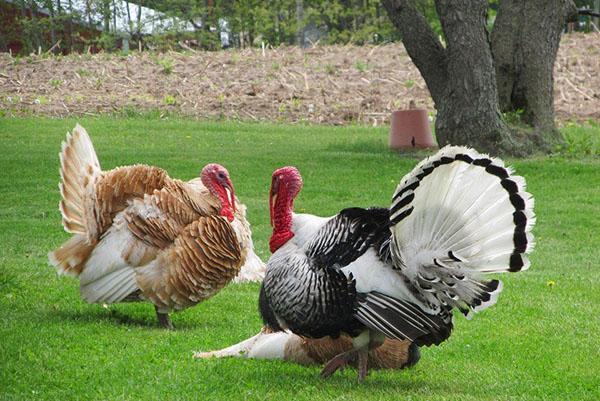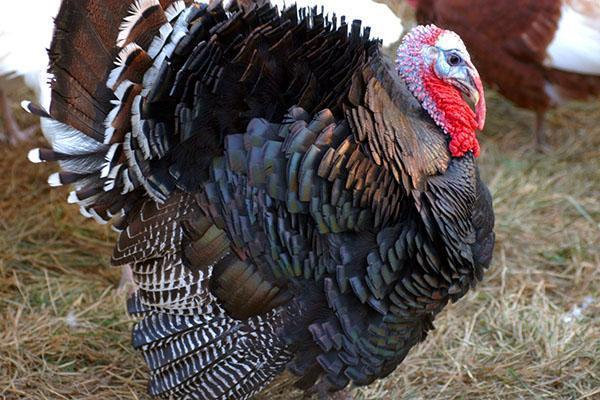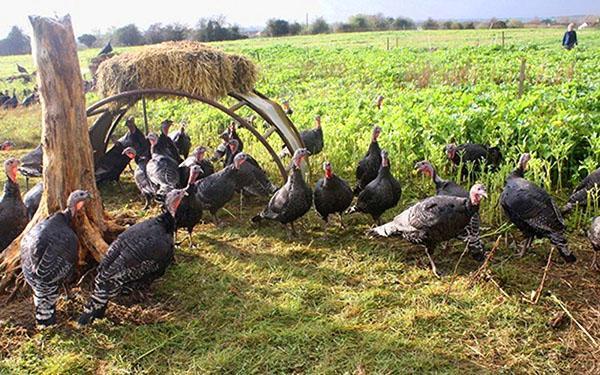Photo and description of turkey breeds
 Domesticated by settlers from the Old World, turkeys have become a kind of symbol of the United States and Canada, but for many centuries large poultry has been grown all over the world. Over the past time, a variety of turkey breeds have been obtained, photos and descriptions of which will help novice poultry breeders make a choice and benefit of this or that variety for their backyard.
Domesticated by settlers from the Old World, turkeys have become a kind of symbol of the United States and Canada, but for many centuries large poultry has been grown all over the world. Over the past time, a variety of turkey breeds have been obtained, photos and descriptions of which will help novice poultry breeders make a choice and benefit of this or that variety for their backyard.
In the last century, poultry attracted the attention of large meat producers. It was from this time that systematic work began on the breeding of heavy wide-breasted and broiler turkeys, which by the time of slaughter grew to a record weight of 25-30 kg.
Modern breeds differ not so much in appearance and color of plumage, but also:
- the time to reach the optimal live weight for slaughter;
- body weight and its ratio with the amount of meat received;
- egg production.
Breeds of turkeys for breeding at home are well adapted to grazing. Such a bird is hardy, quickly gains weight, not picky when choosing feed.
Bronze turkeys

 In females, the color is more modest, but you can recognize the bird by the white edging on the feathers of the wings, chest and back, a more graceful silhouette than the bronze male turkey and the absence of jewelry on the head.
In females, the color is more modest, but you can recognize the bird by the white edging on the feathers of the wings, chest and back, a more graceful silhouette than the bronze male turkey and the absence of jewelry on the head.
The average weight of a turkey reaches 18 kg, and a turkey - 11 kg. The female can lay up to 100 eggs per year.
Birds tolerate outdoor living well even in temperate climates. In Canada, in the middle of the last century, its own variety of bronze turkey was bred with record endurance, decent weight and high egg production. Unfortunately, today this breed of Canadian turkey has practically disappeared from farms. According to the bird census, in 2013 there were only 225 laying hens nationwide. Today, a campaign is underway to reproduce the former livestock and maintain the breed.
 Bred in the USA, the breed of bronze birds, like the Canadian one, descended from wild aboriginal turkeys. But today it is almost never used, giving rise to many more modern lines of poultry.
Bred in the USA, the breed of bronze birds, like the Canadian one, descended from wild aboriginal turkeys. But today it is almost never used, giving rise to many more modern lines of poultry.
Bronze broad-breasted turkeys
 The successor to the bronze turkeys was the bronze broad-chested turkey breed, similar in appearance to its ancestor, but larger in the chest part of the body. The weight turkey an average of 16 kg, and females - 9 kg. The record holder of the breed is a turkey weighing 35 kg.
The successor to the bronze turkeys was the bronze broad-chested turkey breed, similar in appearance to its ancestor, but larger in the chest part of the body. The weight turkey an average of 16 kg, and females - 9 kg. The record holder of the breed is a turkey weighing 35 kg.
Unfortunately, this breed of turkeys is not for home breeding. The reason for this is the relatively low egg production, only 50-60 eggs per year and the inability to walk outdoors. But the bird easily adapts to keeping in industrial poultry houses.
Today, this variety of bronze turkeys is used in breeding work and is raised in intensive poultry farming for meat.
North Caucasian bronze turkeys
 The turkey breed, bred in 1946 in the USSR, is grown at home to this day. The ancestors of the bird were representatives of local varieties of turkey and producers of the breed of broad-breasted, bronze turkeys. Large individuals, well adapting to various conditions of detention, are impressive in size.
The turkey breed, bred in 1946 in the USSR, is grown at home to this day. The ancestors of the bird were representatives of local varieties of turkey and producers of the breed of broad-breasted, bronze turkeys. Large individuals, well adapting to various conditions of detention, are impressive in size.
An adult male grows up to 14 kg. Females are usually half as light. Turkeys rush well and give strong offspring.
Moscow bronze turkeys
 Another domestic breed, the Moscow bronze turkey, was obtained from broad-breasted bronze turkeys and local birds. As follows from the description and photo of the breed, turkeys of this variety have a wide convex chest and a long body. The birds are hardy, they feel great on pastures, which allows them to keep turkeys not only in large poultry houses, but also in private backyards.
Another domestic breed, the Moscow bronze turkey, was obtained from broad-breasted bronze turkeys and local birds. As follows from the description and photo of the breed, turkeys of this variety have a wide convex chest and a long body. The birds are hardy, they feel great on pastures, which allows them to keep turkeys not only in large poultry houses, but also in private backyards.
Males of this breed of turkeys for breeding at home reach a weight of 19 kg. The turkeys are smaller, with a maximum weight of 10 kg.
White broad-breasted turkeys
 In the middle of the last century in the United States, breeders obtained a breed of broiler turkeys, which today occupies undeniable leadership positions throughout the world. White broad-chested turkeys are the result of a cross between the popular Dutch white turkey and Native American bronze broad-chested.
In the middle of the last century in the United States, breeders obtained a breed of broiler turkeys, which today occupies undeniable leadership positions throughout the world. White broad-chested turkeys are the result of a cross between the popular Dutch white turkey and Native American bronze broad-chested.
The reason for the widespread distribution of poultry was its early maturity, a high yield of valuable dietary meat, up to 80% of the carcass weight. Compared to bronze turkeys, female whitebirds produce more eggs, approximately 100 to 120 per year.
Broiler turkeys of this breed have an oval body with a large sloping chest and a full wide back. The bird is well-feathered and fully corresponds to its name. There are no black feathers on the body, except for a small tuft on the sternum. The pink legs, set wide apart, are rather long and strong. The plumage is dense, white, on the chest there is a bunch of black feathers.
 White broad-breasted turkeys in breeding give three lines:
White broad-breasted turkeys in breeding give three lines:
- The heavy line and crosses from it are turkeys weighing up to 25 kg and turkeys up to 11 kg.
- The middle line - males up to 15 and females up to 7 kg.
- Light individuals and crosses from them are the earliest and smallest. Turkeys weighing about 8 kg, and females grow up to 5 kg.
The record figures could not fail to interest poultry meat producers and private poultry lovers. White broad-breasted turkeys have become the founders of many interesting, highly productive breeds and crosses bred around the world.
North Caucasian white turkeys
From the crossing of bronze turkeys and birds of the white broad-breasted breed, a domestic variety of broiler turkeys was obtained - the white North Caucasian turkey.
The breed is distinguished by its endurance, rapid weight gain and excellent egg production, which can be considered a record. An adult turkey is capable of producing up to 180 pieces of 80-gram eggs per year.
The breed intended for breeding at home is easily kept in pastures and uses the most affordable feed.
Photo and description of turkeys BIG 6
 British United Turkeys (BUT) Big 6 is a heavy, highly productive cross of white broad-breasted turkey, actively used in the industrial production of poultry meat. The hybrid line was obtained by British and Canadian breeders. Thanks to the excellent results of local breeding, descriptions and photos of turkeys, the breed has become widespread in many countries of the world in a short time.
British United Turkeys (BUT) Big 6 is a heavy, highly productive cross of white broad-breasted turkey, actively used in the industrial production of poultry meat. The hybrid line was obtained by British and Canadian breeders. Thanks to the excellent results of local breeding, descriptions and photos of turkeys, the breed has become widespread in many countries of the world in a short time.
As you can see in the photo, BIG 6 turkeys are powerful white birds, which have:
- strong long neck;
- round, full breast, in fattened individuals constituting up to a third of the carcass weight;
- straight back;
- high straight legs of yellowish color;
- white plumage with a small black area on the chest.
The heads of broiler turkeys are decorated with scarlet corals and a long, up to 15 cm, equestrian outgrowth.
 Compared to other breeds, BIG 6 turkeys gain weight more actively.By the age of five months, pizza can weigh up to 12 kg. But these are not limiting values. The weight of a heavy cross-country turkey at the time of slaughter can reach 25–30 kg with the highest yield of quality dietary meat.
Compared to other breeds, BIG 6 turkeys gain weight more actively.By the age of five months, pizza can weigh up to 12 kg. But these are not limiting values. The weight of a heavy cross-country turkey at the time of slaughter can reach 25–30 kg with the highest yield of quality dietary meat.